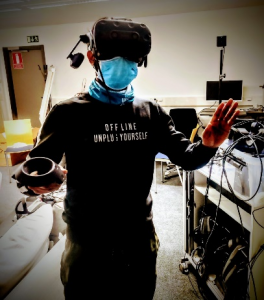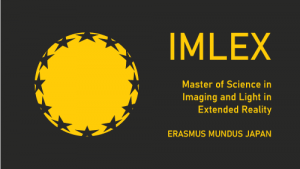Journey to IMLEX
by Niladri Ganguly, 1st year student of IMLEX 2020
 While watching science-fiction movies in my childhood days, I realized that the actions presented were some special effects of the animators and the cinematographers which played a game-changing role behind the scenes but certainly they were imaginary at that time according to my understanding. They were like magical pieces of art that floated in front of me. I tried to find the answers in my science textbooks but I was not satisfied with my findings until I knew that the light can be treated as an electromagnetic wave, and the 3D-glasses work on the principle of polarization and this has a huge role to play.
While watching science-fiction movies in my childhood days, I realized that the actions presented were some special effects of the animators and the cinematographers which played a game-changing role behind the scenes but certainly they were imaginary at that time according to my understanding. They were like magical pieces of art that floated in front of me. I tried to find the answers in my science textbooks but I was not satisfied with my findings until I knew that the light can be treated as an electromagnetic wave, and the 3D-glasses work on the principle of polarization and this has a huge role to play.
Lost in physical phenomena of nature
The fascinating example of the movie theatre and the role of the 3D glasses tend me to take a deep dive into understanding of the physics behind it and go through the course of my Bachelor of Science in Physics. After taking a deep breath of the broad theories there came the interesting lectures of another branch of physics and the definition asked by my professor- “What is optics??!!”- by Prof. L.N. Hazra, University of Calcutta.
The definition of Optics – which was explained to us is the, “Science concerned with the genesis and propagation of EM radiations and its interactions with matters from UV to IR range of the spectrum”. This broad-spectrum is called electromagnetic spectrum which can be utilized to study various properties of nature, materials, matters depending on the wavelength dependencies.
The fascination towards light was started previously when I came to know in Quantum Physics that light can be treated both as wave as well as a particle (the wave particle duality) – the De-Broglie hypothesis. I was explored more into the field of Optics during my B. Tech thesis on – ‘Enhanced resolution in microscopy using converging beam Illumination’, where I learned the resolution plays a huge role in the imaging of minute details and how converging beam could be utilized to achieve enhanced resolution far beyond that achieved by conventional light microscopy. I believe this general method could be used in future in various optical microscopy even in several optical imaging system to get enhanced Super resolution. After my B. Tech I started looking for the Master degree programs in Photonics related field. While applying many courses I found IMLEX program in the Institute of Photonics web page shared by one of my seniors from UEF.
Let us make a coffee break in the reading. By the way, I got to know one of my program countries in the IMLEX program is best coffee consuming countries of the world and it is Finland.
Beginning of IMLEX
Though the acceptance to the IMLEX program was a great start but the year 2020 started giving me pandemic pulses and my courses began in the remote mode ( which was scheduled to be started on campus from the very first day of the September, 2020) as my residence permit process was stopped. My courses were going on remotely where the classroom sessions were conducted online with very interesting lectures on the ‘Fundamentals of Photonics’ along with worst experience in ‘Design & analysis of algorithm’ course which were anyway completely new way of learning science. Anyway, the excitement began after the first week of the November when students accepted to the Master degree programs were given access to travel.
 The first day, I went to the lab I saw some devices placed on our heads with a display system that generates computer vision. Suddenly I was lost again into a different sense of the reality which I have only seen in the movie theatres and saw coming them out of the screen but have not yet interacted and immersed into them. I found myself inside the imaginary world and I can interact with them with the help of the tools called VR controllers which I placed on my hands or on fingertips. But still my mind was thinking of a big question on how the devices work and on what basis or techniques I can see these graphics on display. Then, after spending few days with it, I realized that a huge role of photonics is there in optical design, fabrication and manufacturing procedures which is the effort of variety of expertise in this field. After coming in touch with this technology, I came in touch with the continuum of the reality of these devices. In one end of this reality continuum there is VR (Virtual Reality) and the other parts were occupied by Augmented reality (AR) and hybrid of the two- The Mixed Reality (MR). Further exploration begins when I stepped into the 1st semester project-work in Robotics & XR course on – ‘Teleoperation of robot arms using VR controller interfacing with VR environment’, where as a group work, we are trying to show the robot arm (UR3e) can be controlled in real-time using VR controller and performs some specific tasks.
The first day, I went to the lab I saw some devices placed on our heads with a display system that generates computer vision. Suddenly I was lost again into a different sense of the reality which I have only seen in the movie theatres and saw coming them out of the screen but have not yet interacted and immersed into them. I found myself inside the imaginary world and I can interact with them with the help of the tools called VR controllers which I placed on my hands or on fingertips. But still my mind was thinking of a big question on how the devices work and on what basis or techniques I can see these graphics on display. Then, after spending few days with it, I realized that a huge role of photonics is there in optical design, fabrication and manufacturing procedures which is the effort of variety of expertise in this field. After coming in touch with this technology, I came in touch with the continuum of the reality of these devices. In one end of this reality continuum there is VR (Virtual Reality) and the other parts were occupied by Augmented reality (AR) and hybrid of the two- The Mixed Reality (MR). Further exploration begins when I stepped into the 1st semester project-work in Robotics & XR course on – ‘Teleoperation of robot arms using VR controller interfacing with VR environment’, where as a group work, we are trying to show the robot arm (UR3e) can be controlled in real-time using VR controller and performs some specific tasks.
Transition of next generation of reality: XR world is warming up
The next-generation technologies emerging up does not only include the VR, AR or MR devices but the whole reality continuum has been taken together into one device called the XR (Extended Reality) and the whole world is now on the way to make open XR standards that are still on going under research roadmap and huge improvements are going on with the XR devices and XR technology where Photonics and Computer science experts have challenging role to play. It will not be only used for controlling robots but also used in the real scenarios of the real-world applications and relatively you can make use of this technology to showcase automobiles, medical applications to give instructions for training, in various Optical measurement setup (e.g., XR Microscope) etc. In some sense I can say that XR technology is still warming up and the next decade will be the decade of exploring this technology in daily activities. One can realize the real-word only if one can interact, touch, feel. The XR is the technology which will give you the roadmap to feel the VR environment in the real-time.
Exciting stuffs are ahead and of course the hunt for photonics will be continued…
